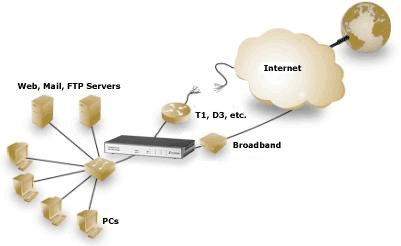 While at IT Expo, I met with Ron Thomas, CEO and Marc Goodman, Director of Marketing for Ecessa (pronounced E-ses-sa), a Plymouth MN appliance manufacturer with an inexpensive load balancing solution to enable ‘last mile survivability.’
While at IT Expo, I met with Ron Thomas, CEO and Marc Goodman, Director of Marketing for Ecessa (pronounced E-ses-sa), a Plymouth MN appliance manufacturer with an inexpensive load balancing solution to enable ‘last mile survivability.’
As I listened to Ron tell me about the company’s transformation from a manufacturer of DSU/CSUs years ago to a manufacturer of PowerLink and ShieldLink appliances for managing various applications for access line survivability – including SIP sessions, I was reminded of a particularly painful experience one friend had with enabling automatic balancing between two access lines (last mile) from different carriers/service providers. My buddy Sri had one DSL circuit with a certain IP address range coming from SBC (it was a few years ago in a big southwestern state) and a cableco connection with a certain other IP address range coming from his local cableco.
The problem was to assure that users anywhere on the Internet could access his servers regardless of the state of any one access line. I searched Google for possible solutions and so on… it was a sad day in Mudsville when I had to admit that I didn’t know…
 … Ron explained to me that DNS is a hierarchical Internet service where ISP’s DNS servers accept their addressing data from other, authoritative servers. In Sri’s case, the appliance sits in the enterprise network between the two links. It authenticates itself to the DNS services of an ISP as the definitive, authoritative DNS server for Sri’s domain. The server sets a time-to-live feature of DNS records at something like thirty seconds and then round-robins the DNS requests between the two IP addresses, and two access lines. This way both services are exercised and you don’t get into circumstances were the backup line was out of service, having failed a month ago, but because it had never been used no-one knew it was out of service until it was needed, and the switchover is less than 30 seconds.
… Ron explained to me that DNS is a hierarchical Internet service where ISP’s DNS servers accept their addressing data from other, authoritative servers. In Sri’s case, the appliance sits in the enterprise network between the two links. It authenticates itself to the DNS services of an ISP as the definitive, authoritative DNS server for Sri’s domain. The server sets a time-to-live feature of DNS records at something like thirty seconds and then round-robins the DNS requests between the two IP addresses, and two access lines. This way both services are exercised and you don’t get into circumstances were the backup line was out of service, having failed a month ago, but because it had never been used no-one knew it was out of service until it was needed, and the switchover is less than 30 seconds.
In Sri’s case, he used one until an outage and then used the other through a manual process of updating DNS servers, waiting for their propagation to occur and so on. Pain.
PowerLinks can be paired back-to-back to enable bonding between multiple access links and up-to-six remote sites for higher performance, or by using the ShieldLink appliance, higher security including VPN Gateway functionality. The portfolio of appliances can also monitor QoS, allocating bandwidth and switching services onto specific links when jitter, delay and packet loss exceed some administrator-set threshold.
The ClariLink WAN Optimization Controller is able to fortify availability of SIP communications in remote offices. Since the appliance incorporates a SIP proxy and registrar, it is intimately involved in the signaling of all outbound and incoming SIP communications. So, if one of the last mile access links fail during a voice or video communication, the SIP proxy can instantly order the RTP stream of traffic to the alternative link saving the communications path. The demo I heard at the show involved a momentary silence of duration probably less than 500 milliseconds, which is barely perceptible by most users.
With ClariLink users avoid having to redial the call and are able to continue the conversation as if nothing had happened. Others can continue after an interruption of one or more minutes depending on how fast the last mile switchover might have occurred. If this circumstance was at my friend Sri’s network, it might have been an hour or more. Clearly, Ecessa shows how survivability pays for small businesses.









